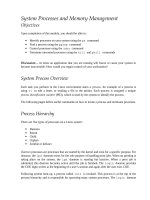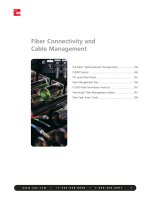Wireless and Mobile Management
Bạn đang xem bản rút gọn của tài liệu. Xem và tải ngay bản đầy đủ của tài liệu tại đây (1.79 MB, 62 trang )
6: Wireless and Mobile Networks 6-1
Chapter 6
Wireless and Mobile
Networks
Computer Networking:
A Top Down Approach
Featuring the Internet
,
3
rd
edition.
Jim Kurose, Keith Ross
Addison-Wesley, July
2004.
A note on the use of these ppt slides:
We’re making these slides freely available to all (faculty, students, readers).
They’re in PowerPoint form so you can add, modify, and delete slides
(including this one) and slide content to suit your needs. They obviously
represent a lot of work on our part. In return for use, we only ask the following:
If you use these slides (e.g., in a class) in substantially unaltered form, that
you mention their source (after all, we’d like people to use our book!)
If you post any slides in substantially unaltered form on a www site, that
you note that they are adapted from (or perhaps identical to) our slides, and
note our copyright of this material.
Thanks and enjoy! JFK/KWR
All material copyright 1996-2006
J.F Kurose and K.W. Ross, All Rights Reserved
6: Wireless and Mobile Networks 6-2
Chapter 6: Wireless and Mobile Networks
Background:
❒
# wireless (mobile) phone subscribers now
exceeds # wired phone subscribers!
❒
computer nets: laptops, palmtops, PDAs,
Internet-enabled phone promise anytime
untethered Internet access
❒
two important (but different) challenges
❍
communication over wireless link
❍
handling mobile user who changes point of attachment
to network
6: Wireless and Mobile Networks 6-3
Chapter 6 outline
6.1 Introduction
Wireless
❒
6.2 Wireless links,
characteristics
❍
CDMA
❒
6.3 IEEE 802.11
wireless LANs (“wi-fi”)
❒
6.4 Cellular Internet
Access
❍
architecture
❍
standards (e.g., GSM)
Mobility
❒
6.5 Principles:
addressing and routing
to mobile users
❒
6.6 Mobile IP
❒
6.7 Handling mobility in
cellular networks
❒
6.8 Mobility and higher-
layer protocols
6.9 Summary
6: Wireless and Mobile Networks 6-4
Elements of a wireless network
network
infrastructure
wireless hosts
❒
laptop, PDA, IP phone
❒
run applications
❒
may be stationary (non-
mobile) or mobile
❍
wireless does
not
always mean mobility
6: Wireless and Mobile Networks 6-5
Elements of a wireless network
network
infrastructure
base station
❒
typically connected to
wired network
❒
relay - responsible for
sending packets
between wired
network and wireless
host(s) in its “area”
❍
e.g., cell towers
802.11 access
points
6: Wireless and Mobile Networks 6-6
Elements of a wireless network
network
infrastructure
wireless link
❒
typically used to
connect mobile(s) to
base station
❒
also used as backbone
link
❒
multiple access
protocol coordinates
link access
❒
various data rates,
transmission distance
6: Wireless and Mobile Networks 6-7
Characteristics of selected wireless link
standards
384 Kbps
56 Kbps
54 Mbps
5-11 Mbps
1 Mbps
802.15
802.11b
802.11{a,g}
IS-95 CDMA, GSM
UMTS/WCDMA, CDMA2000
.11 p-to-p link
2G
3G
Indoor
10 – 30m
Outdoor
50 – 200m
Mid range
outdoor
200m – 4Km
Long range
outdoor
5Km – 20Km
6: Wireless and Mobile Networks 6-8
Elements of a wireless network
network
infrastructure
infrastructure mode
❒
base station connects
mobiles into wired
network
❒
handoff: mobile
changes base station
providing connection
into wired network
6: Wireless and Mobile Networks 6-9
Elements of a wireless network
Ad hoc mode
❒
no base stations
❒
nodes can only
transmit to other
nodes within link
coverage
❒
nodes organize
themselves into a
network: route among
themselves
6: Wireless and Mobile Networks 6-10
Wireless Link Characteristics
Differences from wired link ….
❍
decreased signal strength: radio signal
attenuates as it propagates through matter
(path loss)
❍
interference from other sources: standardized
wireless network frequencies (e.g., 2.4 GHz)
shared by other devices (e.g., phone); devices
(motors) interfere as well
❍
multipath propagation: radio signal reflects off
objects ground, arriving ad destination at
slightly different times
…. make communication across (even a point to point)
wireless link much more “difficult”
6: Wireless and Mobile Networks 6-11
Wireless network characteristics
Multiple wireless senders and receivers create
additional problems (beyond multiple access):
A
B
C
Hidden terminal problem
❒
B, A hear each other
❒
B, C hear each other
❒
A, C can not hear each other
means A, C unaware of their
interference at B
A
B
C
A’s signal
strength
space
C’s signal
strength
Signal fading:
❒
B, A hear each other
❒
B, C hear each other
❒
A, C can not hear each other
interferring at B
6: Wireless and Mobile Networks 6-12
Code Division Multiple Access (CDMA)
❒
used in several wireless broadcast channels
(cellular, satellite, etc) standards
❒
unique “code” assigned to each user; i.e., code set
partitioning
❒
all users share same frequency, but each user has
own “chipping” sequence (i.e., code) to encode data
❒
encoded signal
= (original data) X (chipping
sequence)
❒
decoding:
inner-product of encoded signal and
chipping sequence
❒
allows multiple users to “coexist” and transmit
simultaneously with minimal interference (if codes
are “orthogonal”)
6: Wireless and Mobile Networks 6-13
CDMA Encode/Decode
slot 1
slot 0
d
1
= -1
1 1 1
1
1
-
1
-
1
- 1
-
Z
i,m
= d
i
.
c
m
d
0
= 1
1 1 1
1
1
-
1
-
1
- 1
-
1 1 1
1
1
-
1
-
1
- 1
-
1 1 1
1
1
-
1
-
1
- 1
-
slot 0
channel
output
slot 1
channel
output
channel output Z
i,m
sender
code
data
bits
slot 1
slot 0
d
1
= -1
d
0
= 1
1 1 1
1
1
-
1
-
1
- 1
-
1 1 1
1
1
-
1
-
1
- 1
-
1 1 1
1
1
-
1
-
1
- 1
-
1 1 1
1
1
-
1
-
1
- 1
-
slot 0
channel
output
slot 1
channel
output
receiver
code
received
input
D
i
= Σ
Z
i,m
.
c
m
m=1
M
M
6: Wireless and Mobile Networks 6-14
CDMA: two-sender interference
6: Wireless and Mobile Networks 6-15
Chapter 6 outline
6.1 Introduction
Wireless
❒
6.2 Wireless links,
characteristics
❍
CDMA
❒
6.3 IEEE 802.11
wireless LANs (“wi-fi”)
❒
6.4 Cellular Internet
Access
❍
architecture
❍
standards (e.g., GSM)
Mobility
❒
6.5 Principles:
addressing and routing
to mobile users
❒
6.6 Mobile IP
❒
6.7 Handling mobility in
cellular networks
❒
6.8 Mobility and higher-
layer protocols
6.9 Summary
6: Wireless and Mobile Networks 6-16
IEEE 802.11 Wireless LAN
❒
802.11b
❍
2.4-5 GHz unlicensed
radio spectrum
❍
up to 11 Mbps
❍
direct sequence spread
spectrum (DSSS) in
physical layer
•
all hosts use same
chipping code
❍
widely deployed, using
base stations
❒
802.11a
❍
5-6 GHz range
❍
up to 54 Mbps
❒
802.11g
❍
2.4-5 GHz range
❍
up to 54 Mbps
❒
All use CSMA/CA for
multiple access
❒
All have base-station
and ad-hoc network
versions
6: Wireless and Mobile Networks 6-17
802.11 LAN architecture
❒
wireless host communicates
with base station
❍
base station = access
point (AP)
❒
Basic Service Set (BSS)
(aka “cell”) in infrastructure
mode contains:
❍
wireless hosts
❍
access point (AP): base
station
❍
ad hoc mode: hosts only
BSS 1
BSS 2
Internet
hub, switch
or router
AP
AP
6: Wireless and Mobile Networks 6-18
802.11: Channels, association
❒
802.11b: 2.4GHz-2.485GHz spectrum divided into
11 channels at different frequencies
❍
AP admin chooses frequency for AP
❍
interference possible: channel can be same as
that chosen by neighboring AP!
❒
host: must
associate
with an AP
❍
scans channels, listening for
beacon frames
containing AP’s name (SSID) and MAC address
❍
selects AP to associate with
❍
may perform authentication [Chapter 8]
❍
will typically run DHCP to get IP address in AP’s
subnet
6: Wireless and Mobile Networks 6-19
IEEE 802.11: multiple access
❒
avoid collisions: 2
+
nodes transmitting at same time
❒
802.11: CSMA - sense before transmitting
❍
don’t collide with ongoing transmission by other node
❒
802.11:
no
collision detection!
❍
difficult to receive (sense collisions) when transmitting due to
weak received signals (fading)
❍
can’t sense all collisions in any case: hidden terminal, fading
❍
goal:
avoid collisions:
CSMA/C(ollision)A(voidance)
A
B
C
A
B
C
A’s signal
strength
space
C’s signal
strength
6: Wireless and Mobile Networks 6-20
IEEE 802.11 MAC Protocol: CSMA/CA
802.11 sender
1 if sense channel idle for DIFS then
transmit entire frame (no CD)
2 if sense channel busy then
start random backoff time
timer counts down while channel idle
transmit when timer expires
if no ACK, increase random backoff
interval, repeat 2
802.11 receiver
- if frame received OK
return ACK after SIFS (ACK needed due to
hidden terminal problem)
sender
receiver
DIFS
data
SIFS
ACK
6: Wireless and Mobile Networks 6-21
Avoiding collisions (more)
idea:
allow sender to “reserve” channel rather than random
access of data frames: avoid collisions of long data frames
❒
sender first transmits
small
request-to-send (RTS) packets
to BS using CSMA
❍
RTSs may still collide with each other (but they’re short)
❒
BS broadcasts clear-to-send CTS in response to RTS
❒
RTS heard by all nodes
❍
sender transmits data frame
❍
other stations defer transmissions
Avoid data frame collisions completely
using small reservation packets!
6: Wireless and Mobile Networks 6-22
Collision Avoidance: RTS-CTS exchange
AP
A
B
time
R
T
S
(
A
)
R
T
S
(
B
)
R
T
S
(
A
)
C
T
S
(
A
)
C
T
S
(
A
)
DATA (A)
A
C
K
(
A
)
A
C
K
(
A
)
reservation collision
defer
6: Wireless and Mobile Networks 6-23
frame
control
duration
address
1
address
2
address
4
address
3
payload CRC
2 2 6 6 6 2
6
0 - 2312
4
seq
control
802.11 frame: addressing
Address 2: MAC address
of wireless host or AP
transmitting this frame
Address 1: MAC address
of wireless host or AP
to receive this frame
Address 3: MAC address
of router interface to
which AP is attached
Address 4: used only
in ad hoc mode
6: Wireless and Mobile Networks 6-24
Internet
router
AP
H1
R1
AP MAC addr H1 MAC addr R1 MAC addr
address 1
address 2
address 3
802.11 frame
R1 MAC addr AP MAC addr
dest. address
source address
802.3 frame
802.11 frame: addressing
6: Wireless and Mobile Networks 6-25
frame
control
duration
address
1
address
2
address
4
address
3
payload CRC
2 2 6 6 6 2
6
0 - 2312
4
seq
control
Type
From
AP
Subtype
To
AP
More
frag
WEP
More
data
Power
mgt
Retry Rsvd
Protocol
version
2
2 4 1 1 1 1 1 11 1
802.11 frame: more
duration of reserved
transmission time (RTS/CTS)
frame seq #
(for reliable ARQ)
frame type
(RTS, CTS, ACK, data)









